Uncoupled Precipitation and Water Availability: The Case Study of Municipality of Sfakia, Crete, Greece
Abstract
1. Introduction
2. Methodology
3. Karstification and Highly Permeability of Geological Layers
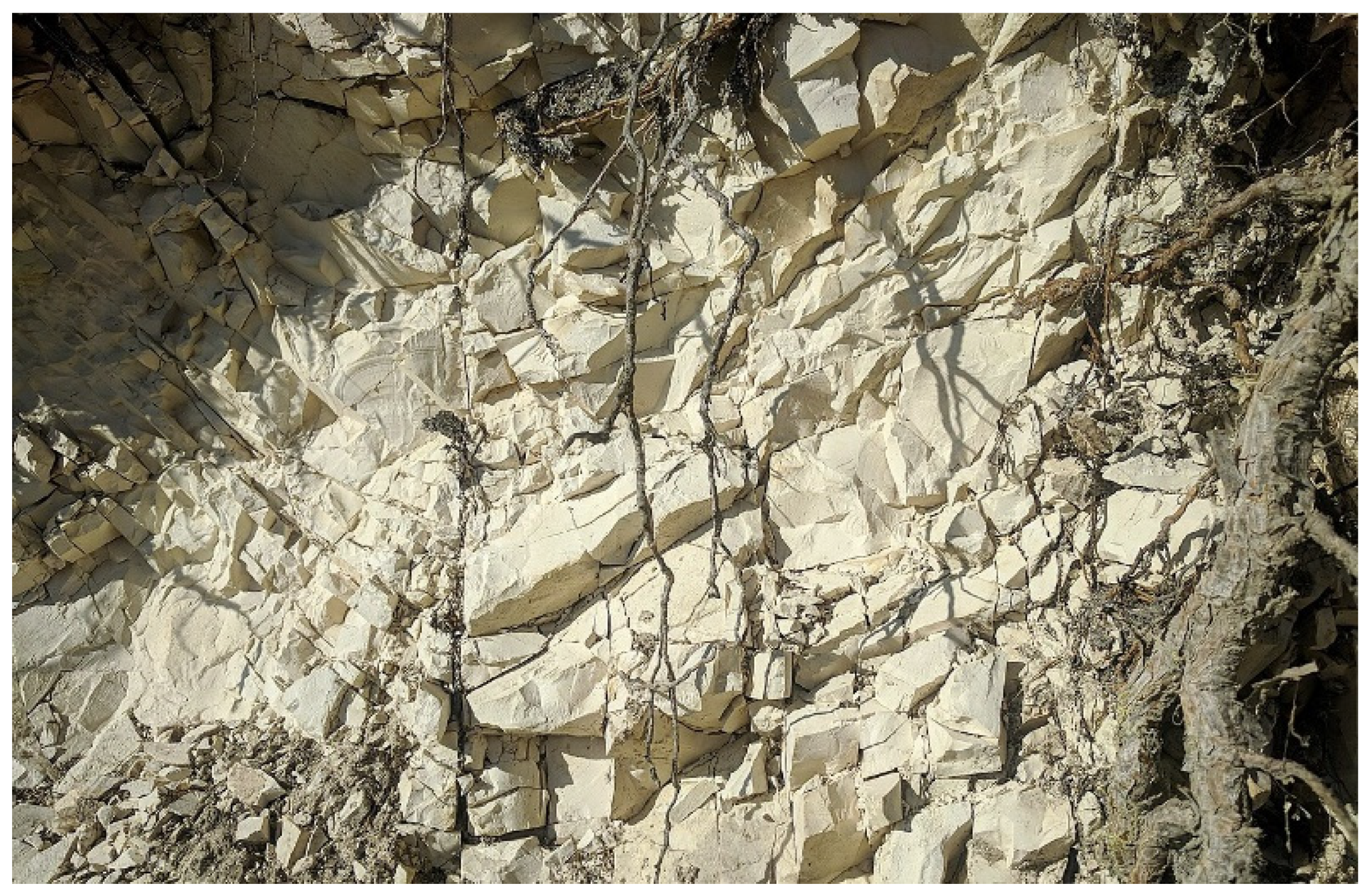
4. Physical Settings
4.1. Climate
- (a)
- The annual duration of sunshine is longer in the coastal zone compared to the mountainous zones, where the average annual sunshine is limited by cloud formation that is favored by the surrounding geomorphology.
- (b)
- The temperature variations are milder in coastal zone compared to mountainous areas (temperature difference between day and night). From October to April, lower temperature values are recorded in the eastern mountainous area, due to the northerly currents, which explain the more frequent snowing and frost, particularly early in the morning.
- (c)
- The humidity factor also differs between the three zones, due mainly to variations in the altitude. The coastal zones show higher hygrometric conditions compared to mountainous areas, which is ascribed to sea proximity, but, again, the hygrometric conditions of the southern coastal areas are higher than those of the northern coastal areas. An important role in the differentiation hydrometric conditions is the frequent appearance of the north currents (“Meltemi”), especially during the summer period.
- (d)
- Both mountainous areas show higher rainfall and snowfall compared to the eastern mountainous areas. The low coastal zones do not have high rainfall, and there are a number of surface streams–gorges that are reflected throughout the southern front of the municipality.
4.2. Geology
4.2.1. Geomorphology
4.2.2. The Geological Structure of the Sfakia—“Lefka Ori” Mountains Area
4.2.3. Permeability and Infiltration
4.2.4. Overview of Land Cover, Soil Types and Hydrogeology
5. Historical Information of Water Supply
- (a)
- LC of Askyfou: In June 1867, in Askyfou, a battle took place between Ottomans under Mehmet Pasha and the Sfakians. The Sfakians repulsed and trapped the Turks in Kares, until Resit Pasha came to their aid. Due to the heat and the lack of water, they were forced to leave Askyfou [55].
- (b)
- LC of Anopolis: Anopolis is located in the synonymous plateau 13 km west of Chora, Sfakia. It is a small plateau formed below the Sfakiani Madara, which is considered to be one of the most inaccessible provinces in Europe. In the place of the present village of Anopolis was built the ancient city, which has been there since the Venetian time.
- (c)
- LC Chora of Sfakia: The city of Chora is located on the south coast of Western Crete, near the end of the beautiful gorge of Imvros. During the Venetian occupation, the settlement was referred to as Obrosgialos; in the following years, it was called Sfakia and finally acquired its current name. It is the capital of the municipality, with 265 inhabitants in 2011.
- (d)
- In Asfentou, there are numerous rainwater cisterns. Before World War II, there were over 100 cisterns. Each family had at least one cistern. Most of them were made by stone with a special cleaning entrance (Figure 14a). In the village of Vouva, the water supply was based on rainwater cisterns. There were family and community cisterns. A community one located at the western entrance of the settlement, approximately 50 m from the main road, is shown in Figure 14b. It was rebuilt in 1935 on a pre-existing one. In Imvros there are in the same place, at the eastern end of the settlement, 4–5 square cisterns/wells, a few meters away from each other and of an average depth of 15 m (Figure 14c). Each belonged to a family. Finally, a rainwater cistern with a dome is found right at the entrance to the settlement of ancient Aradena, shown in Figure 14d.
- (e)
- LC Agia Roumeli: The water supply of the old settlement of Agia Roumeli, as well as the newer one, was based on springs of the gorge of Samaria. For this purpose, stone made terracotta conduits, and, recently, PVC pipes have been used.
6. Current Water Management and Water Supply in the Area of Sfakia: Problems and Future Challenges
6.1. Water Management and Water Supply
6.2. Current and Future Challenges
7. Epilogue
Author Contributions
Funding
Acknowledgments
Conflicts of Interest
References
- Tramblay, Y.; Llasat, M.C.; Randin, C.; Coppola, E. Climate change impacts on water resources in the Mediterranean. Reg. Environ. Chang. 2020, 20, 83. [Google Scholar] [CrossRef]
- Morote, Á.-F.; Olcina, J.; Hernández, M. The Use of Non-Conventional Water Resources as a Means of Adaptation to Drought and Climate Change in Semi-Arid Regions: South-Eastern Spain. Water 2019, 11, 93. [Google Scholar] [CrossRef]
- Malek, Ž.; Verburg, P.H.; Geijzendorffer, I.R.; Bondeau, A.; Cramer, W. Global change effects on land management in the Mediterranean region. Glob. Environ. Chang. 2018, 50, 238–254. [Google Scholar] [CrossRef]
- Ait-Mouheb, N.; Mayaux, P.-L.; Mateo-Sagasta, J.; Hartani, T.; Molle, B. Chapter 5—Water reuse: A resource for Mediterranean agriculture. In Water Resources in the Mediterranean Region; Zribi, M., Brocca, L., Tramblay, Y., Molle, F., Eds.; Elsevier: Amsterdam, The Netherlands, 2020; pp. 107–136. [Google Scholar] [CrossRef]
- Tzanakakis, V.A.; Paranychianakis, N.V.; Angelakis, A.N. Water Supply and Water Scarcity. Water 2020, 12, 2347. [Google Scholar] [CrossRef]
- Cramer, W.; Guiot, J.; Fader, M.; Garrabou, J.; Gattuso, J.-P.; Iglesias, A.; Lange, M.A.; Lionello, P.; Llasat, M.C.; Paz, S. Climate change and interconnected risks to sustainable development in the Mediterranean. Nat. Clim. Chang. 2018, 8, 972–980. [Google Scholar] [CrossRef]
- Molina, M.O.; Sánchez, E.; Gutiérrez, C. Future heat waves over the Mediterranean from an Euro-CORDEX regional climate model ensemble. Sci. Rep. 2020, 10, 8801. [Google Scholar] [CrossRef] [PubMed]
- Russo, A.; Gouveia, C.M.; Dutra, E.; Soares, P.M.M.; Trigo, R.M. The synergy between drought and extremely hot summers in the Mediterranean. Environ. Res. Lett. 2019, 14, 014011. [Google Scholar] [CrossRef]
- Chartzoulakis, K.S.; Paranychianakis, N.V.; Angelakis, A.N. Water resources management in the Island of Crete, Greece, with emphasis on the agricultural use. Water Policy 2001, 3, 193–205. [Google Scholar] [CrossRef]
- Mascaro, G.; Viola, F.; Deidda, R. Evaluation of Precipitation From EURO-CORDEX Regional Climate Simulations in a Small-Scale Mediterranean Site. J. Geophys. Res. Atmos. 2018, 123, 1604–1625. [Google Scholar] [CrossRef]
- Koshida, G.; Cohen, S.; Mortsch, L. Climate and water availability indicators in Canada: Challenges and a way forward. Part I —Indicators. Can. Water Resour. J. Rev. Can. Des Ressour. Hydr. 2015, 40, 133–145. [Google Scholar] [CrossRef]
- Pavlakis, P. The major Hydraulic Projects of Crete. In Proceedings of the Available Water Resources Projects’ Management. Workshop on "Dams and Reservoirs in Crete: Design, Construction & Management of Large Hydraulic Works". OAK, Heraklion, Crete, 21 March 2014; 2014. (In Greek). [Google Scholar]
- Pavlakis, P.; Pavlaki, A. Water Resources Planning & Management Schemes of Crete. Potential for increasing available water resources in western Crete. In Proceedings of the 11th ICOLD European Club Symposium, Chania, Greece, 2–4 October 2019. [Google Scholar]
- Pavlakis, P. A Contribution to the Hydrogeological Investigation of the Calcareous Aquifer of Agyia Springs, West Crete. Ph.D. Thesis, School of Civil Engineering, Aristotle University of Thessaloniki, Thessaloniki, Greece, 1989. (In Greek). [Google Scholar]
- Pavlakis, P.; Lydakis, A.P.; Simantiris, N. Exploitation of the important Water Resources in Chania Prefecture, in order to meet the Irrigation & Water Supply demands. In Proceedings of the Conference Promotion of Development & Environmental Infrastructure Projects—ESPA 2007–2013, Technical Chamber of Greece, Department of Western Crete, Chania, Crete, 30–31 January 2010. (In Greek). [Google Scholar]
- Kalantzis, K. Tradition in the Frame: Photography, Power, and Imagination in Sfakia, Crete; Indiana University Press: Bloomington, IN, USA, 2019. [Google Scholar]
- Mountrakis, D.; Kilias, A.; Pavlaki, A.; Fassoulas, C.; Thomaidou, E.; Papazachos, C.; Papaioannou, C.; Roumelioti, Z.; Benetatos, C.; Vamvakaris, D. Neotectonic study of Western Crete and implications for seismic hazard assessment. J. Virtual Explor. 2012, 42, 2. [Google Scholar] [CrossRef]
- Pavlaki, A. Engineering Geological Conditions in Chania Prefecture, Crete Island. Ph.D. Thesis, School of Civil Engineering, Aristotle University of Thessaloniki, Thessaloniki, Greek, 2008. (In Greek). [Google Scholar]
- Pavlaki, A.; Meladiotis, I.; Pavlakis, P. Applicability of the “Lefka Ori” Western Crete region “GeoFactors” Interaction Matrix (GFIM) as a key to understanding the engineering geological condtions. Bull. Geol. Soc. Greece 2013, 47, 1820–1833. [Google Scholar] [CrossRef][Green Version]
- Adamopoulos, K. 1000 and 1 caves in “Lefka Ori” massif, on Crete, Greece. In Proceedings of the 16th International Congress of Speleology, Brno, Czech Republic, 21 July 2013; pp. 21–28. [Google Scholar]
- Fytrolakis, N. The geological Structure of Crete. Bachelor’s Thesis, National Technology University of Athens, Athens, Greece, 1980. (In Greek). [Google Scholar]
- Plymakis, A. Caves in Chania Area: Some Beautiful and Interesting Caves; Book; Plymakis: Chania, Greece, 2002; 417p. [Google Scholar]
- Tzanakakis, V.; Angelakis, A.; Paranychianakis, N.; Dialynas, Y.; Tchobanoglous, G. Challenges and Opportunities for Sustainable Management of Water Resources in the Island of Crete, Greece. Water 2020, 12, 1538. [Google Scholar] [CrossRef]
- AGI. American Geological Institute. Karst, a Renewable Water Resource in Limestone Rocks, Encyclopedia of the Environment. 1972. Available online: https://www.encyclopedie-environnement.org/en/water/karst-renewable-water-resource-in-limestone-rocks/ (accessed on 20 October 2021).
- Johnson, T.C. Origin of sedimentary rocks (Second edn.), H. Blatt, G. Middleton, and R. Murray, Prentice-Hall, Inc., 1980. Earth Surf. Processes Landf. 1981, 6, 97. [Google Scholar] [CrossRef]
- Abdullah, F.H. Porosity and permeability of karst carbonate rocks along an unconformity outcrop: A case study from the Upper Dammam Formation exposure in Kuwait, Arabian Gulf. Heliyon 2021, 7, e07444. [Google Scholar] [CrossRef]
- Thornbury, W.D. Principles of Geomorphology, 2nd ed.; Wiley: New York, NY, USA, 1969; pp. 303–344. ISBN 0471861979. [Google Scholar]
- Smith, D. Landforms of Alberta; Interpreted from Airphotos and Satellite Imagery. Alberta Remote Sensing Center. Alta. Environ. Publ. 1987. Available online: .https://www.worldcat.org/title/landforms-of-alberta-interpreted-from-airphotos-and-satellite-imagery/oclc/24706971 (accessed on 20 October 2021).
- Available online: https://en.wikipedia.org/wiki/Karst#/media/File:Limestone_Eocene_deposit_at_Sinj_Stari_grad_-_Dalmatia_-_Croatia_IMG_20210820_083857.jpg (accessed on 10 January 2022).
- Bakalowicz, M. Karst at depth below the sea level around the Mediterranean due to the Messinian crisis of salinity. Hydrogeological consequences and issues. Geol. Belg. 2014, 17, 96–101. [Google Scholar]
- Bonacci, O.; Fistanic, I.; Split, C. Contribution to hydrological analysis of the coastal karst spring Almyros (Crete, Greece). In Proceedings of the Conference on Water Observation and Information System for Decision Support, Balwois, Ohrid, FYROM, UNDP-Agency of Skopje, Crete, Greece, 25–29 May 2004; pp. 191–192. [Google Scholar]
- Voudouris, K.; Alexopoulos, A.; Antonakos, A.; Kallergis, G. Water Resources in the wider area of the Aposelemis Basin, Crete Island, Greece. Bulletin of the Geological Society of Greece. In Proceedings of the 11th International Congress, Athens, Greece, 24–26 May 2007. [Google Scholar]
- Kazakis, N.; Chalikakis, K.; Mazzilli, N.; Ollivier, C.; Manakos, A.; Voudouris, K. Management and research strategies of karst aquifers in Greece: Literature overview and exemplification based on hydrodynamic modelling and vulnerability assessment of a strategic karst aquifer. Sci. Total Environ. 2018, 643, 592–609. [Google Scholar] [CrossRef]
- Steiakakis, E. Evaluation of Exploitable Groundwater Reserves in Karst Terrain: A Case Study from Crete, Greece. Geosciences 2018, 8, 19. [Google Scholar] [CrossRef]
- Agou, V.D.; Varouchakis, E.A.; Hristopulos, D.T. Geostatistical analysis of precipitation in the island of Crete (Greece) based on a sparse monitoring network. Env. Monit Assess 2019, 191, 353. [Google Scholar] [CrossRef]
- Varouchakis, E.A.; Corzo, G.A.; Karatzas, G.P.; Kotsopoulou, A. Spatio-temporal analysis of annual rainfall in Crete, Greece. Acta Geophys. 2018, 66, 319–328. [Google Scholar] [CrossRef]
- Pavlaki, A.; Perlreros, V.; Fasoulas, C.; Lionis, M.; Lioni, A.; Mountrakis, D.; Kilias, A.; Thomaidou, E.; Pavlakis, P.; Goumenaki, P.; et al. Geological study and relevation of the Lefka Ori Crete mountains geoenviroment dynamism. In Proceedings of the 3rd International Geo-Cultural Symposium ”Samaria 2016”, Chania/Crete, Greece, 13–15 May 2016. [Google Scholar]
- Kilias, A. Late Orogenic Extension in the Hellenic Orogen. In Proceedings of the 9th International Congress, Athens, Greece, September 2001; pp. 149–156. [Google Scholar]
- Mountrakis, D. Orogenic evolution on the Hellenic Orogen.Geometry & Kinematics. In Proceedings of the 9th International Congress, Athens, Greece, 3 September 2001; pp. 2113–2126. [Google Scholar]
- Ten Veen, J.H.; Kleinspehn, K.L. Incipient continental collision and plate-boundary curvature: Late Pliocene–Holocene transtensional Hellenic forearc, Crete, Greece. J. Geol. Soc. 2003, 160, 161–181. [Google Scholar] [CrossRef]
- Mountrakis, D.; Kilias, A.; Pavlaki, A.; Fassoulas, C.; Thomaidou, C. Neotectonic Study of the Northern Part of Western Crete—Neotectonic & Geological Map Sc. 1:50.000; Inter-Municipal Cooperation between 11 Municipalities of the Chania Prefecture; Department of Geology, Aristotle University of Thessaloniki: Thessaloniki, Greece, 2004. [Google Scholar]
- Fassoulas, C.; Kilias, A.; Mountrakis, D. Postnappe stacking extension and exhumation of high-pressure/low-temperature rocks in the island of Crete, Greece. Tectonics 1994, 13, 127–138. [Google Scholar] [CrossRef]
- Kilias, A.; Fassoulas, C.; Mountrakis, D. Tertiary extension of continental crust and uplift of Psiloritis metamorphic core complex in the central part of the Hellenic Arc (Crete, Greece). In Active Continental Margins—Present and Past; Giese, P., Behrmann, J., Eds.; Springer: Berlin/Heidelberg, Germany, 1994. [Google Scholar]
- Seidel, E.; Kreuzer, H.; Harre, W. A late Oligocene/early Miocene high pressure belt in the external Hellenides. Geol. Jahrbuch. Reihe E Geophys. 1982, 23, 165–206. [Google Scholar]
- IGSR. Institute for Geology & Subsurface Research, 1969, 1971. Geological Map of Greece. Sc. 1:50.000. Sheet Alikianou (1969) by Tataris & Christodoyloy. Sheet Chania (1971) by Karageorgiou. 1969.
- Pavlaki, A.; Mountrakis, D.; Kilias, A. Geological Map sc 1:25.000 & Geological Study of the Northwestern Part of the Lefka Ori Mountains Area; Technical University of Crete: Chania, Greece, 1990. (In Greek) [Google Scholar]
- Demiris, K.; Meladiotis, I. Investigation of the Myloniana Karstic aquifer (northern part of the Lefka Ori Mountains—West Crete), for the determination of boreholes drilling positions in the framework of the ground water exploitation. Technical Report; OADYK: Chania, Greece, 1983. (In Greek) [Google Scholar]
- Meladiotis, I.; Dermisis, B.; Pavlakis, P. Groundwater flow mechanism of the Agyias springs—Lefka Ori Mountains carbonated karst aquifer system in Western Crete. In Proceedings of the 5th Conference of the Hellenic Hydrotechnical Association, Larissa, Greece, 9–12 November 1992; pp. 259–266. [Google Scholar]
- Pavlakis, P. Master Plan of the Water Resources’ Hydraulic Projects along the Northern Zone of the Island of Crete; Technical Study & Maps, Prefecture of Crete: Heraklion, Greece, 1999. [Google Scholar]
- Demiris, K.; Meladiotis, I.; Pavlakis, P. Map of Tectonic Discontinuities of the Island of Crete & Hydrological Data. Sheet: Crete, Sc. 1:200.000; OADYK—Laboratory of Engineering Geology, Department of Civil Engineering AUTh: Thessaloniki, Greek, 1992. (In Greek) [Google Scholar]
- Leveque, Ρ. Rapport de Synthèse Sur Les Études Effectuées par Télédétection et Analyses Isotopiques, en Crète Occidentale; Lab.Rad.& Μec.Roches, Université de Βordeaux: Βordeaux, France, 1973; pp. 1–25. [Google Scholar]
- Leveque, Ρ. Crète Occidentale—Carte Thermographique; L.R.M.R.; Université de Bordeaux: Βordeaux, France, 1974. [Google Scholar]
- Leveque, Ρ. Hydrogéologie Karstique et Télédétection: Utilisation de la Télédétection et du Tritium Pour l Établissement du Premier Inventaire des Ressources Hydrologiques en Crète Occidentale; t 283 Série D; C. R. Acad. Sc. Paris: Paris, France, 1976; pp. 1025–1028. [Google Scholar]
- Pavlakis, P.; Mpletsas, A.; Kountouris, S.; Yiotis, A.; Vounousakis, D.; Tetraktys; Fragidakis, D.; Karavokiris, G.; Daoutis, I.; Eythimiatos, I. Development of Water Resources for Irrigation & Water Supply in Western Crete. Final Studies; Ministry of Public Works, 1978, 1980, 1982; Hydraulic Works Department. Directorate of Studies: Athens, Greece, 1983. (In Greek) [Google Scholar]
- Fragouli, A. Province of Sfakion; Ministry of Environment: Athens, Greece, 1997; p. 260.
- CMD. Common Ministerial Decision. Management Plan as a River Basin of the Water Region of Crete; No 896, ΦΕΚ Β/4666/2017; Ministry of Environment, Energy and Climate Change: Athens, Greece, 2017. (In Greek)
- EEA. European Environment Agency. Report No 6. Tracking Progress towards Europe’s Climate and Energy Targets until 2020. In Trends and Projections in Europe 2014; 2014. Available online: https://www.eea.europa.eu/publications/trends-and-projections-in-europe-2014 (accessed on 20 October 2021).
- Koutsoyiannis, D.; Zarkadoulas, N.; Angelakis, A.N.; Tchobanoglous, G. Urban water management in Ancient Greece: Legacies and lessons. J. Water Resour. Plan. Manag. 2008, 134, 45–54. [Google Scholar] [CrossRef]
- Ispikoudis, I.; Lyrintzis, G.; Kyriakakis, S. Impact of human activities on Mediterranean landscapes in western Crete. Landsc. Urban Plan. 1993, 24, 259–271. [Google Scholar] [CrossRef]
- Jacob, D.; Kotova, L.; Teichmann, C.; Sobolowski, S.P.; Vautard, R.; Donnelly, C.; Koutroulis, A.G.; Grillakis, M.G.; Tsanis, I.K.; Damm, A.; et al. Climate Impacts in Europe Under +1.5°C Global Warming. Earth’s Future 2018, 6, 264–285. [Google Scholar] [CrossRef]
- Vautard, R.; Gobiet, A.; Sobolowski, S.; Kjellström, E.; Stegehuis, A.; Watkiss, P.; Mendlik, T.; Landgren, O.; Nikulin, G.; Teichmann, C. The European climate under a 2 C global warming. Environ. Res. Lett. 2014, 9, 034006. [Google Scholar] [CrossRef]
- Tsanis, I.K.; Koutroulis, A.G.; Daliakopoulos, I.N.; Jacob, D. Severe climate-induced water shortage and extremes in Crete. Clim. Chang. 2011, 106, 667–677. [Google Scholar] [CrossRef]
- Ruman, S.; Tichavský, R.; Šilhán, K.; Grillakis, M.G. Palaeoflood discharge estimation using dendrogeomorphic methods, rainfall-runoff and hydraulic modelling—A case study from southern Crete. Nat. Hazards 2021, 105, 1721–1742. [Google Scholar] [CrossRef]
- Koutroulis, A.G.; Grillakis, M.G.; Daliakopoulos, I.N.; Tsanis, I.K.; Jacob, D. Cross sectoral impacts on water availability at +2°C and +3°C for east Mediterranean island states: The case of Crete. J. Hydrol. 2016, 532, 16–28. [Google Scholar] [CrossRef]
- Koutroulis, A.G.; Tsanis, I.K.; Daliakopoulos, I.N.; Jacob, D. Impact of climate change on water resources status: A case study for Crete Island, Greece. J. Hydrol. 2013, 479, 146–158. [Google Scholar] [CrossRef]
- Brilli, L.; Lugato, E.; Moriondo, M.; Gioli, B.; Toscano, P.; Zaldei, A.; Leolini, L.; Cantini, C.; Caruso, G.; Gucci, R.; et al. Carbon sequestration capacity and productivity responses of Mediterranean olive groves under future climates and management options. Mitig Adapt. Strateg. Glob Chang. 2019, 24, 467–491. [Google Scholar] [CrossRef]
- Chartzoulakis, K.; Psarras, G. Global change effects on crop photosynthesis and production in Mediterranean: The case of Crete, Greece. Agric. Ecosyst. Environ. 2005, 106, 147–157. [Google Scholar] [CrossRef]
- Georgopoulou, E.; Mirasgedis, S.; Sarafidis, Y.; Vitaliotou, M.; Lalas, D.P.; Theloudis, I.; Giannoulaki, K.D.; Dimopoulos, D.; Zavras, V. Climate change impacts and adaptation options for the Greek agriculture in 2021–2050: A monetary assessment. Clim. Risk Manag. 2017, 16, 164–182. [Google Scholar] [CrossRef]
- CMD. Common Ministerial Decision. Management Plan as a River Basin of the Water Region of Crete; No 163. ΦΕΚ 570/B’/2015; Ministry of Environment, Energy and Climate Chang.: Athens, Greece, 2015. (In Greek)
- Menegaki, A.N.; Hanley, N.; Tsagarakis, K.P. The social acceptability and valuation of recycled water in Crete: A study of consumers’ and farmers’ attitudes. Ecol. Econ. 2007, 62, 7–18. [Google Scholar] [CrossRef]
- Paranychianakis, N.V.; Salgot, M.; Snyder, S.A.; Angelakis, A.N. Water Reuse in EU States: Necessity for Uniform Criteria to Mitigate Human and Environmental Risks. Crit. Rev. Environ. Sci. Technol. 2015, 45, 1409–1468. [Google Scholar] [CrossRef]
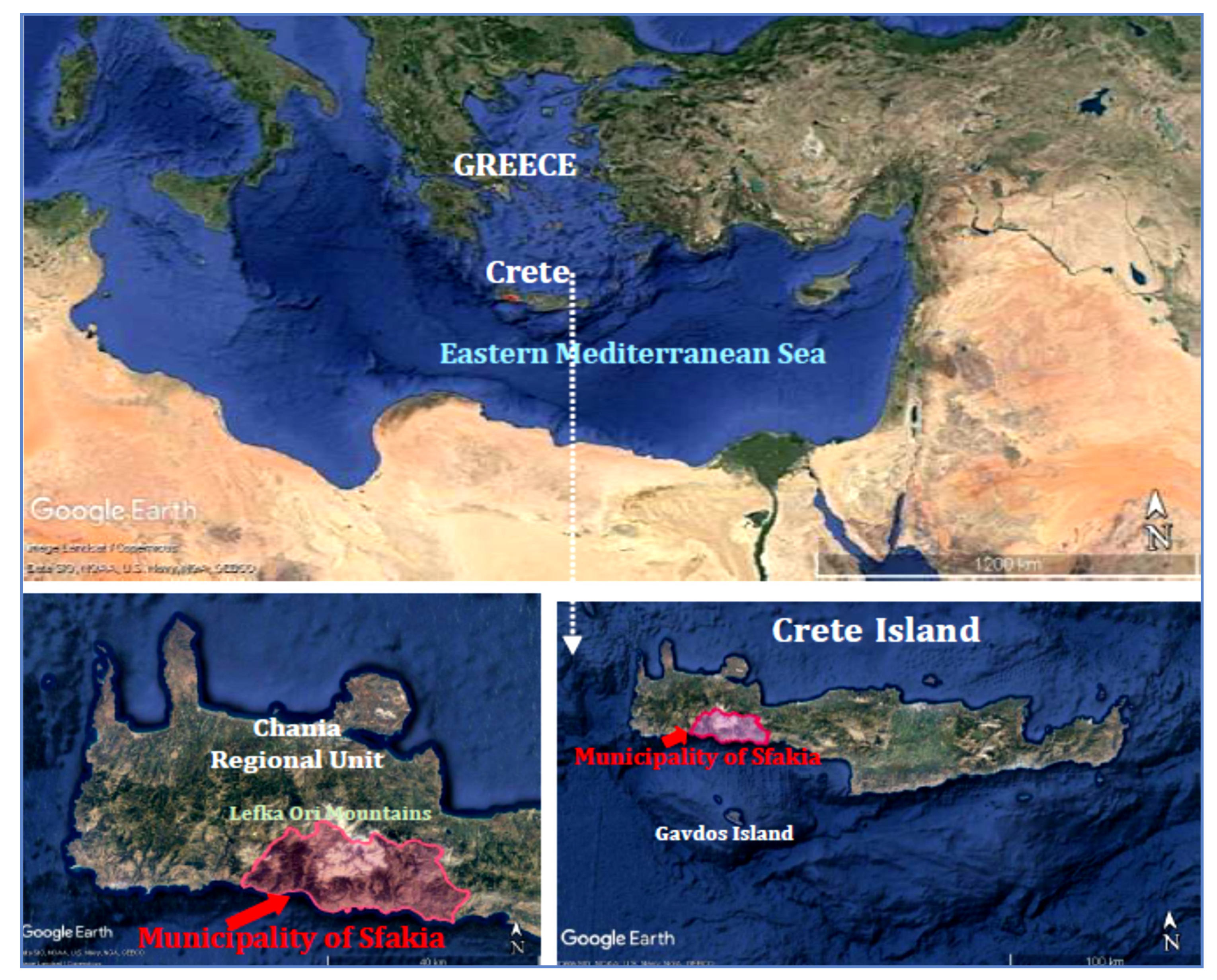
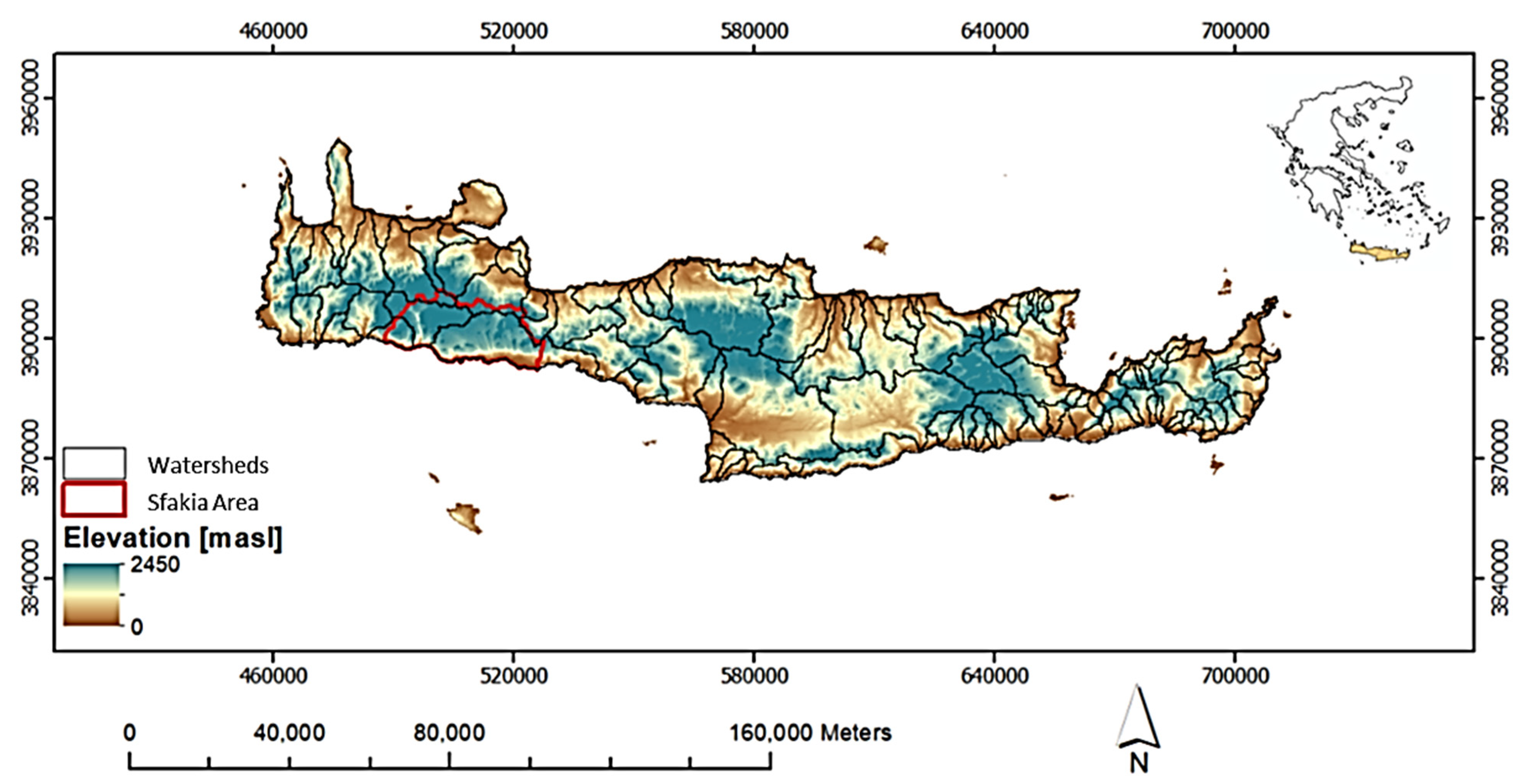
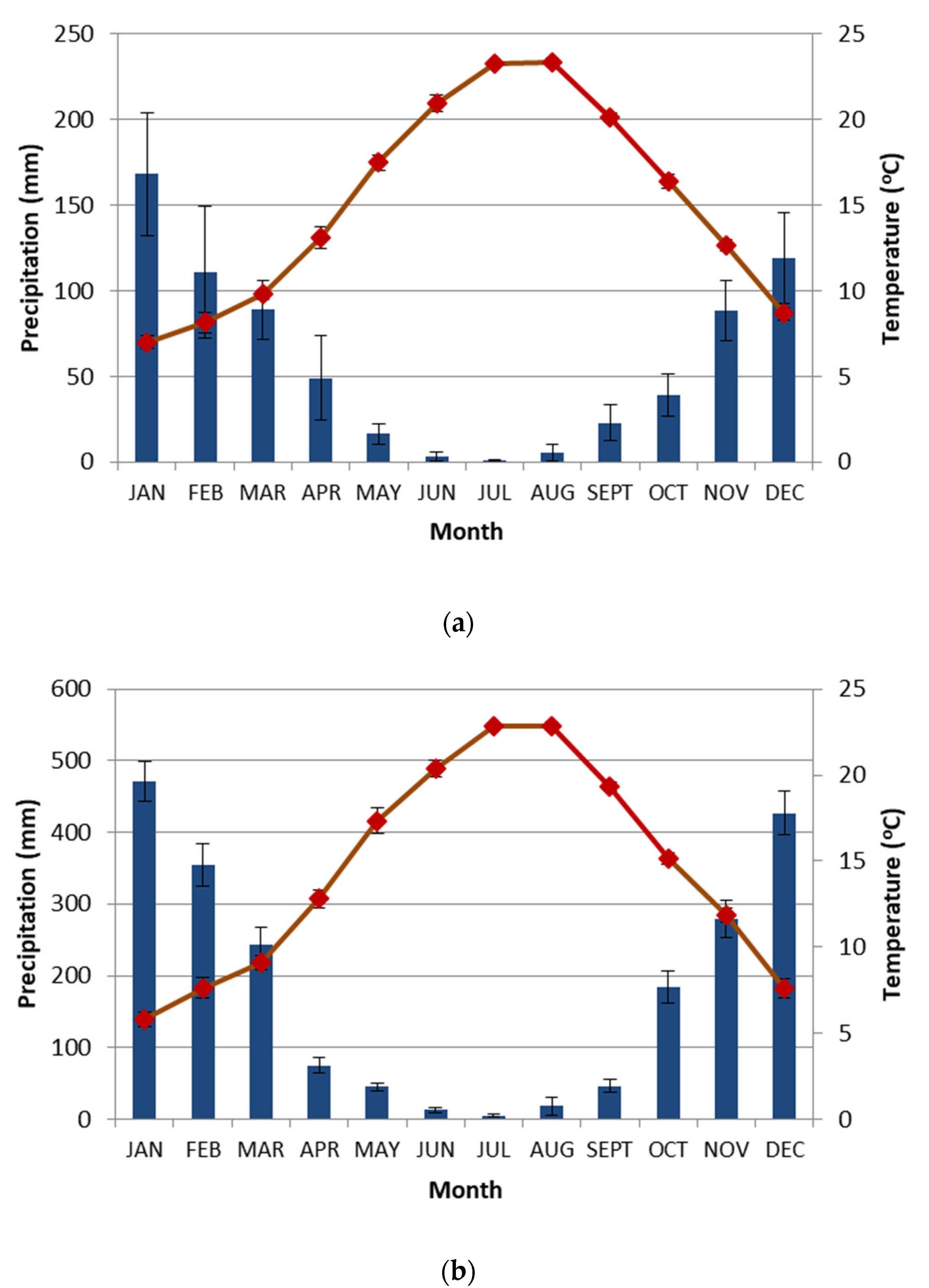
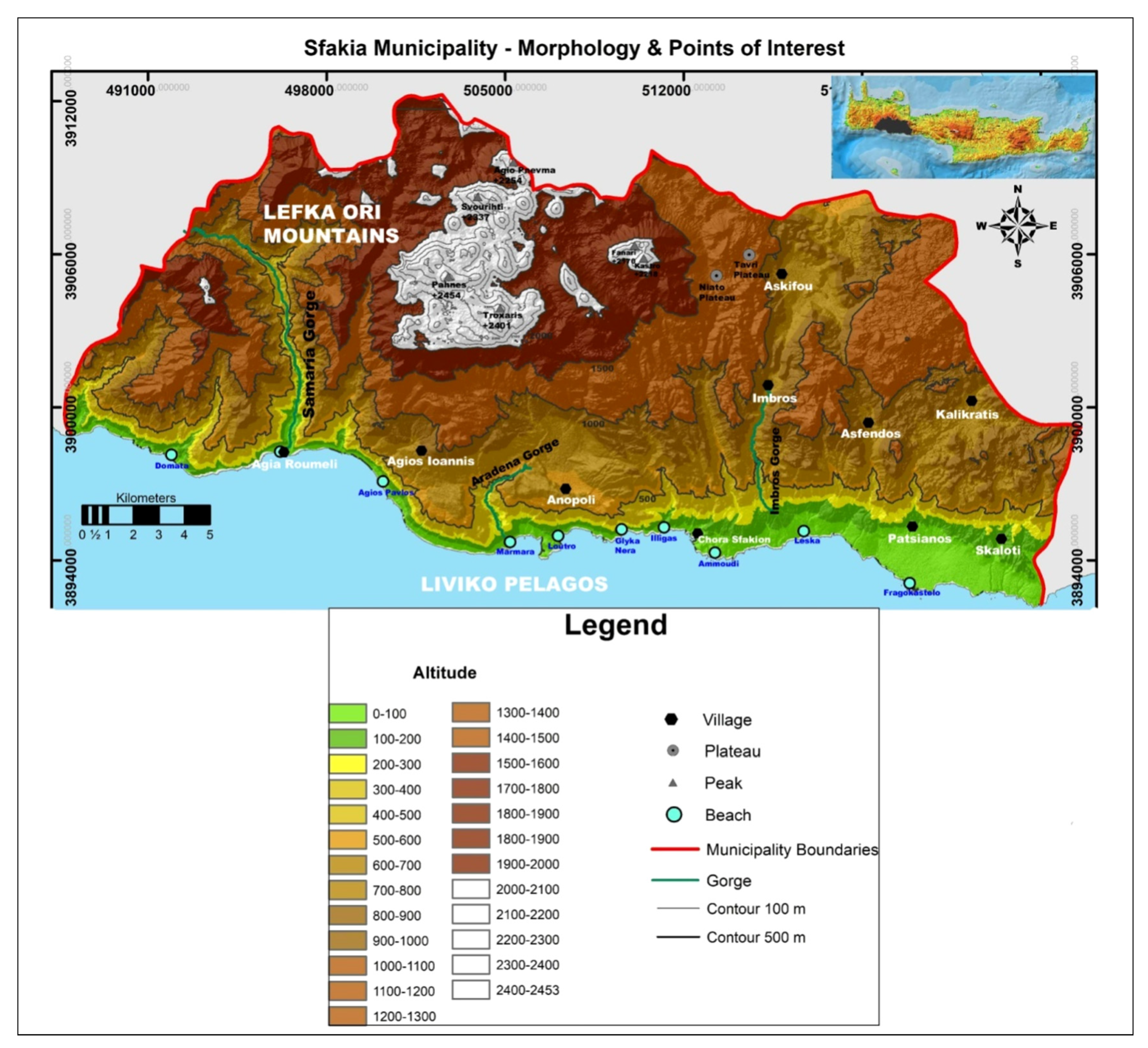
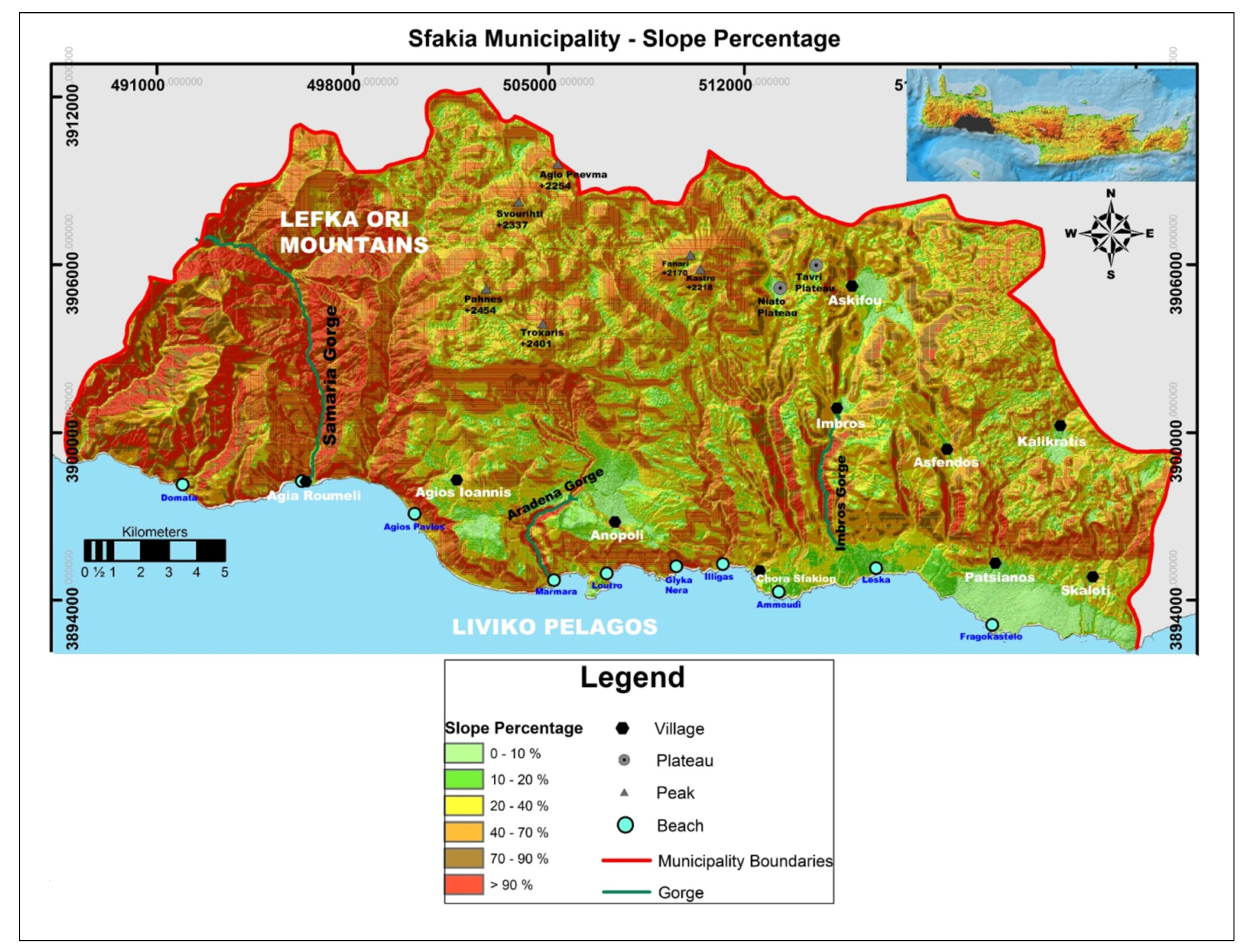


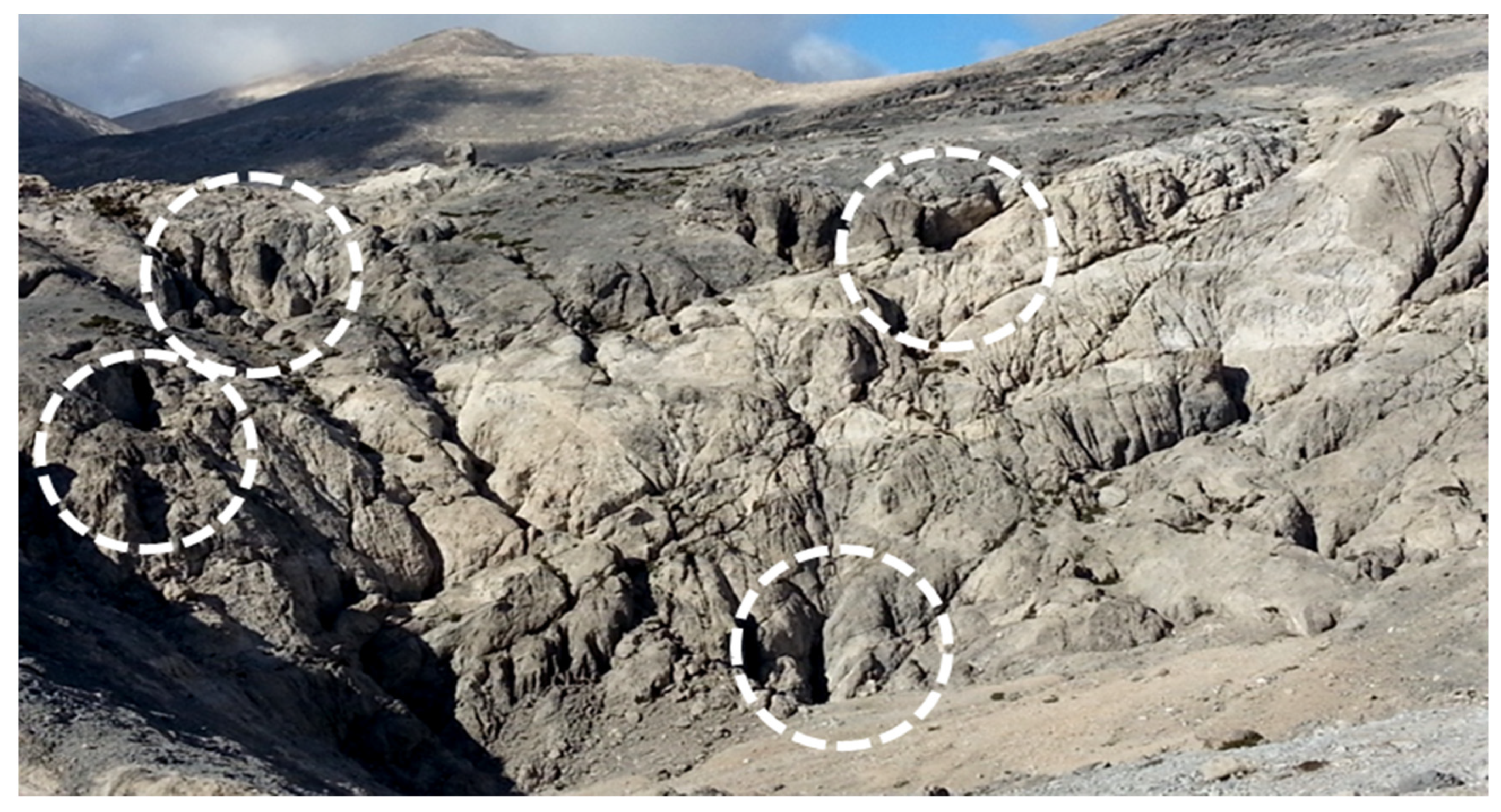




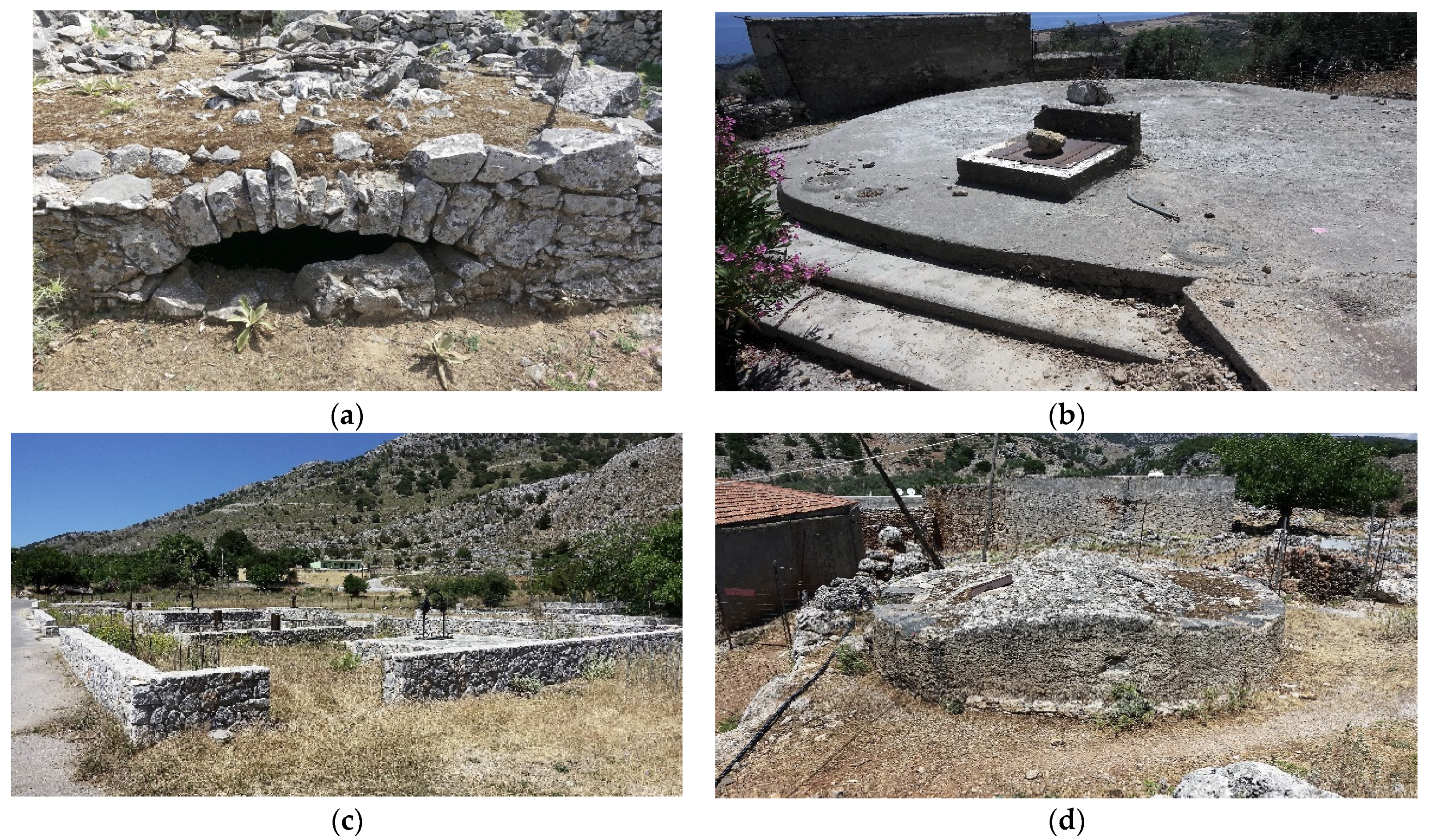
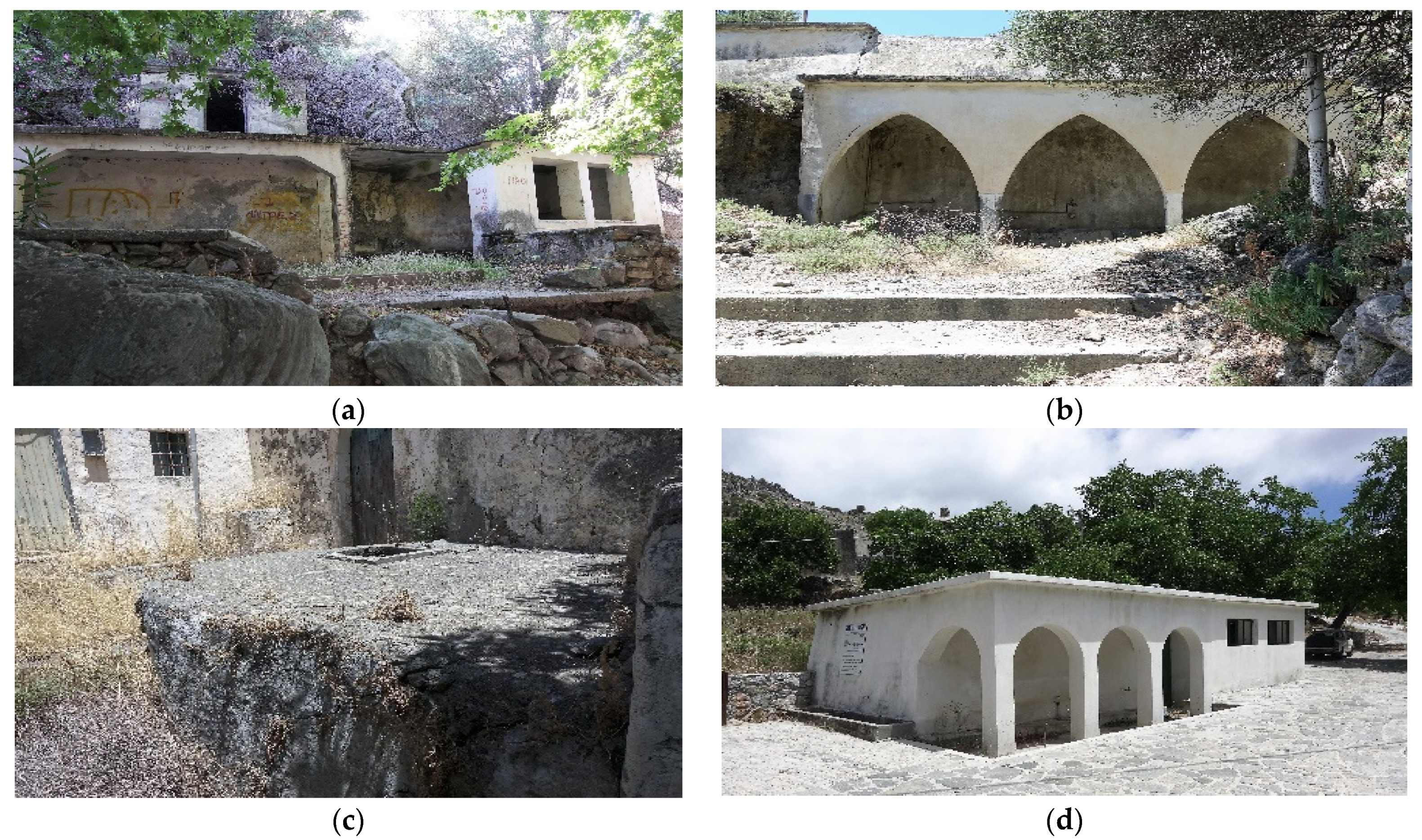
Publisher’s Note: MDPI stays neutral with regard to jurisdictional claims in published maps and institutional affiliations. |
© 2022 by the authors. Licensee MDPI, Basel, Switzerland. This article is an open access article distributed under the terms and conditions of the Creative Commons Attribution (CC BY) license (https://creativecommons.org/licenses/by/4.0/).
Share and Cite
Tzanakakis, V.A.; Pavlaki, A.; Lekkas, E.; Varouchakis, E.A.; Paranychianakis, N.V.; Fasarakis, G.; Angelakis, A.N. Uncoupled Precipitation and Water Availability: The Case Study of Municipality of Sfakia, Crete, Greece. Water 2022, 14, 462. https://doi.org/10.3390/w14030462
Tzanakakis VA, Pavlaki A, Lekkas E, Varouchakis EA, Paranychianakis NV, Fasarakis G, Angelakis AN. Uncoupled Precipitation and Water Availability: The Case Study of Municipality of Sfakia, Crete, Greece. Water. 2022; 14(3):462. https://doi.org/10.3390/w14030462
Chicago/Turabian StyleTzanakakis, Vasileios A., Aikaterini Pavlaki, Emmanouil Lekkas, Emmanouil A. Varouchakis, Nikolaos V. Paranychianakis, Giorgos Fasarakis, and Andreas N. Angelakis. 2022. "Uncoupled Precipitation and Water Availability: The Case Study of Municipality of Sfakia, Crete, Greece" Water 14, no. 3: 462. https://doi.org/10.3390/w14030462
APA StyleTzanakakis, V. A., Pavlaki, A., Lekkas, E., Varouchakis, E. A., Paranychianakis, N. V., Fasarakis, G., & Angelakis, A. N. (2022). Uncoupled Precipitation and Water Availability: The Case Study of Municipality of Sfakia, Crete, Greece. Water, 14(3), 462. https://doi.org/10.3390/w14030462









